As a result of so many people working from home due to the COVID-19 pandemic, videoconferencing has seen a rise unlike any other time in the history of the technology. While many legacy remote employees have been using videoconferencing to connect with employees for years, those used to being in the office are experiencing major videoconferencing for the first time.
It’s certainly an adjustment, but one that many have made even in their personal lives. Zoom videoconferencing has seen a surge of private users conferencing with friends and family they’re unable to visit as more states and countries are locked down. While the company has seen its share of cybersecurity issues as a result, it hasn’t seemed to slow the proliferation of videoconferencing on the commercial and consumer sides alike.
A recent article from the BBC discusses the concept of “Zoom fatigue,” what can be more largely referred to as videoconferencing fatigue. The BBC spoke with experts on why fatigue may be occurring, and what people can do about it. To break it down into bullet points to save time, the experts point to several factors:
- Screens freeze and cause disruptions to conversations
- Videoconferencing requires more focus than in-person chat
- We are very aware we’re being watched when videoconferencing
- We feel forced to make this calls, and feel obligated to join even personal calls
- Aspects of our lives that once felt separate (work and private life) now occur in the same space on the same platforms
The experts suggest only having necessary meetings, putting the screen off to the side, making the video aspect non-mandatory, and, believe it or not, writing letters to loved ones instead of videoconferencing with them.
With all due respect to the experts, I think that this is a fabricated problem. First, the article points to no statistics suggesting this fatigue even exists. Meanwhile, statistics can be found to show the major growth in videoconferencing app downloads during this time.
In fact I’d argue that the private meetings between friends and family show just the opposite of fatigue. It’s not possible now for many people to meet face to face, and videoconferencing gives them an avenue to see one another instead of just hearing each other over the phone. It’s easy to say that face-to-face communication is better than videoconferencing, but that’s ignoring the fact that videoconferencing is the closest thing we have to face-to-face when being together isn’t an option.
The same goes for the workplace. The article argues that videoconferencing with coworkers just reminds us that we’re not with them in the office where we should be. Ignore the old-school rhetoric that work only happens in the office, the logic behind the statement is backward. We’re videoconferencing with coworkers because we can’t see them in the office. If all we needed to do was give information an email would suffice. But videoconferencing allows us some semblance of normalcy.
Spare me the idea that we feel we’re being watched when videoconferencing. If you’re the main speaker in any meeting you know you’re being watched. If you’re not the main speaker on a videoconference, odds are no one is watching you. It’s not much different from a typical meeting in-person.
I think that people are fatigued working from home and not being able to go out and do what they normally do. That means going to work, going to restaurants with friends, attending sporting events, going golfing, and so on. That’s where fatigue comes from. Videoconferencing offers us an opportunity to see people we otherwise wouldn’t, and engage in more effective communication than what happens over chat or voice alone.
Many of us are fatigues amid this pandemic. Videoconferencing is not the reason why. If anything, it’s helping curb that fatigue by allowing people to connect when they can’t do so in person. That’s always been the ROI of videoconferencing, and it doesn’t change just because we’re doing more of it.
If you enjoyed this article and want to receive more valuable industry content like this, click here to sign up for our digital newsletters!











Leave a Reply